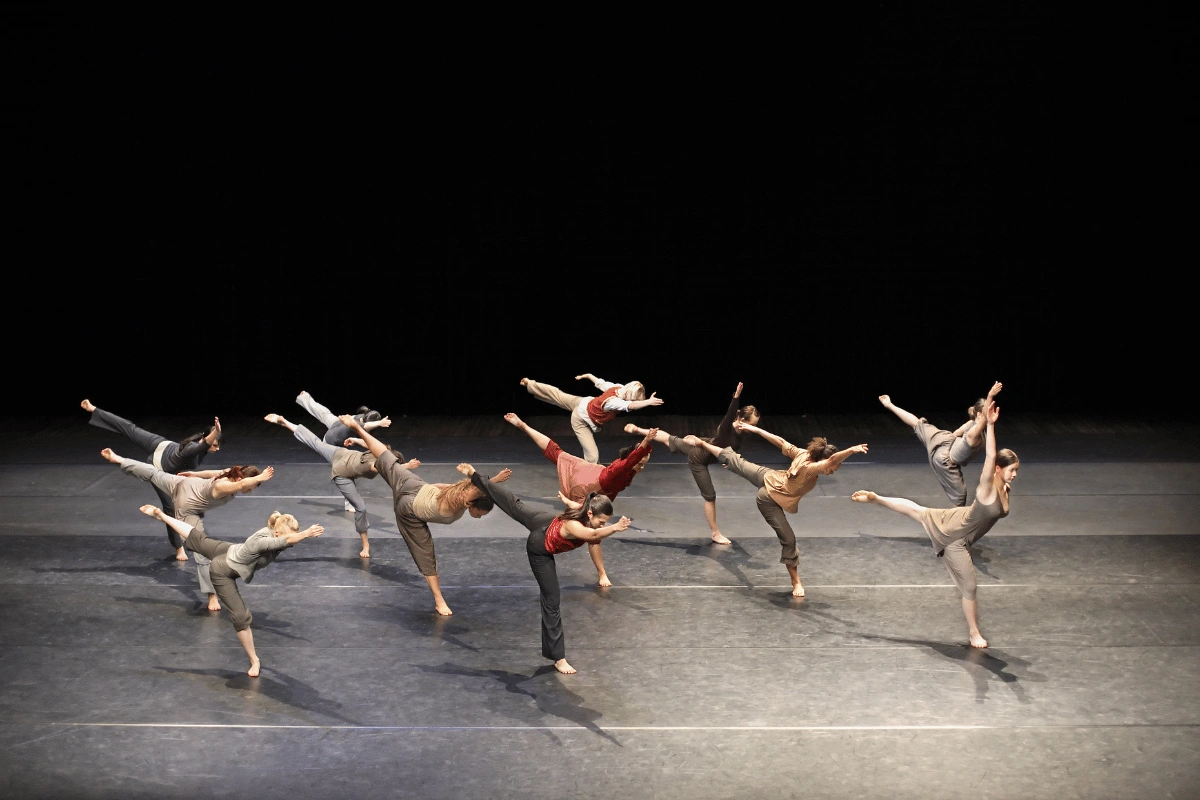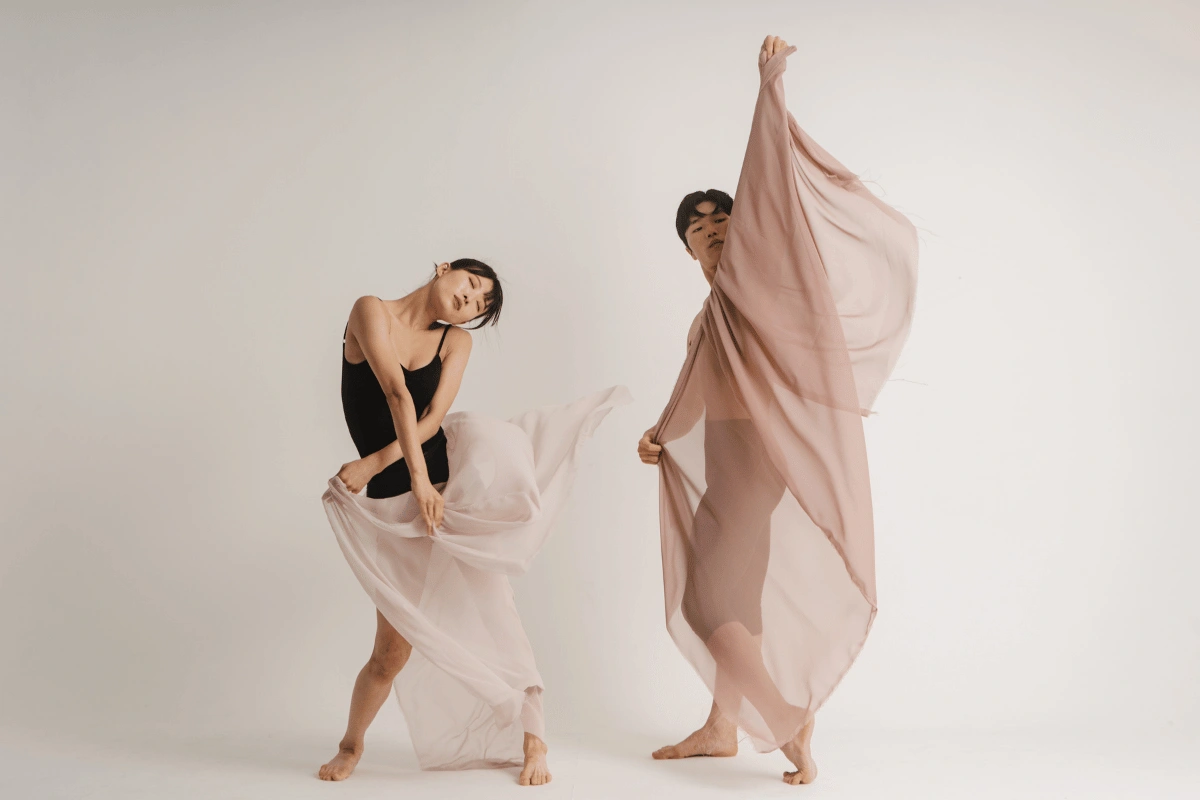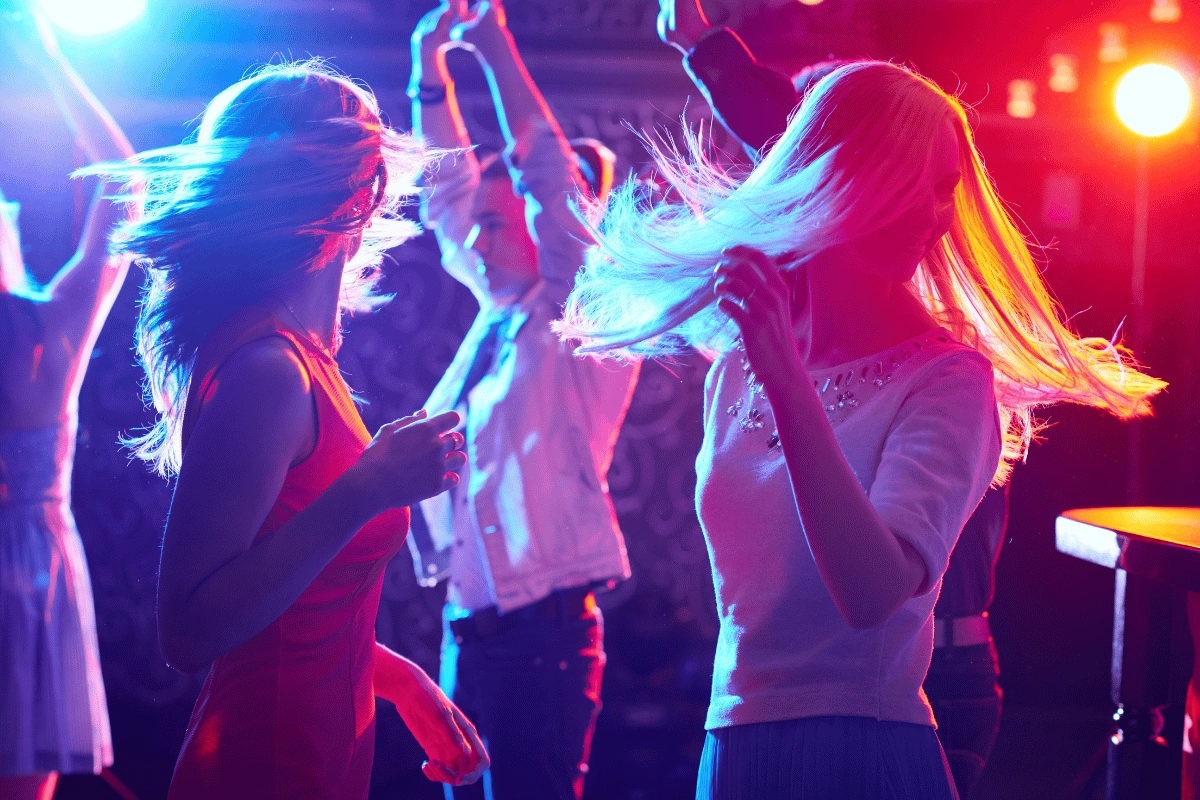Welcome back to our dance journey! In the first part of “Dance Terms Every Beginner Dancer Should Know,” we delved into the fundamental vocabulary essential for anyone stepping onto the dance floor for the first time. Now, in Part 2, we’re excited to continue expanding your dance lexicon. Whether you’re rehearsing in the studio or improvising at a social dance event, having a solid grasp of these additional terms will boost your confidence and enhance your ability to follow along and communicate with fellow dancers. So, let’s lace up those dance shoes and dive deeper into the captivating world of dance terminology!
Mark
In the dance world, “marking” a piece of choreography refers to performing it with reduced energy or intensity, typically during rehearsals or practice sessions. This approach allows dancers to focus on refining aspects such as musicality, timing, and spatial awareness without exerting full physical effort, akin to a rehearsal or warm-up.
Marking enables dancers to maintain a heightened level of awareness and precision in their movements, as they can concentrate on aligning their actions with the musical phrasing and choreographic cues. By dialing down the intensity, dancers can also conserve energy and reduce the risk of fatigue or injury during extended rehearsal periods.
Moreover, marking allows dancers to explore nuances and subtleties within the choreography, such as transitions, accents, and dynamics, with greater clarity and attention to detail. It provides an opportunity to experiment with different interpretations and variations of movement, facilitating artistic exploration and refinement.
Choreographers often use percentages to indicate the level of energy or effort expected when marking a routine. For example, they may instruct dancers to mark at 50% or 80% intensity, providing a clear guideline for the degree of engagement required. This allows dancers to adjust their approach accordingly, ensuring consistency and uniformity within the ensemble.

Milking
In dance, “milking” refers to the deliberate extension or elongation of movements, typically performed during a specific portion of a dance piece or musical phrase. This technique involves prolonging the duration of a movement rather than abruptly ending it, creating a sense of continuity, expression, and emphasis within the choreography.
Instead of simply “putting a period” on a movement and abruptly stopping it, milking involves extending the movement as if it were punctuated with ellipses, or “…”, signaling a deliberate elongation or lingering quality. This approach allows dancers to draw out the essence and impact of a movement, infusing it with heightened emotion, drama, or style.
Milking can be applied to various aspects of movement, including gestures, poses, transitions, and even facial expressions, depending on the artistic intent of the choreography. By extending movements, dancers can add depth, complexity, and texture to their performance, enhancing the overall visual and emotional impact.
Moreover, milking is often used to emphasize key moments or themes within a dance piece, drawing attention to specific movements or motifs. It allows dancers to fully inhabit and explore the nuances of their choreography, bringing a sense of authenticity and depth to their performance.
Additionally, milking requires a keen sense of musicality and timing, as dancers must synchronize their movements with the rhythm and phrasing of the accompanying music. By elongating movements in response to musical cues, dancers can create dynamic contrasts, accents, and syncopations that enhance the overall cohesion and coherence of the choreography.
Musicality
In the realm of dance, musicality encompasses the intricate art of synchronizing movement with the rhythm, sounds, and emotional nuances of the accompanying music. It transcends mere physical execution, embodying a deep connection and responsiveness to the musical elements that shape the dance experience.
“Dance musicality” manifests in a myriad of ways, reflecting the unique style, interpretation, and creative expression of each dancer. It involves not only matching movement to the beat but also interpreting the mood, dynamics, and phrasing of the music with precision and sensitivity.
One aspect of musicality involves aligning movement with the rhythmic structure of the music, including beats, accents, and tempo changes. Dancers may execute steps, gestures, and transitions in harmony with the underlying pulse of the music, creating a sense of rhythmic cohesion and synchronicity.
Furthermore, dance musicality encompasses the ability to interpret and express the emotional content of the music through movement. Dancers may use dynamics, spatial patterns, and gestures to convey the mood, energy, and narrative of the music, evoking a range of emotions and responses from the audience.
Additionally, dance musicality involves incorporating stylistic elements and techniques that complement the genre, mood, and cultural context of the music. Whether it’s the intricate footwork of tap dance, the fluid isolations of contemporary dance, or the expressive gestures of classical ballet, dancers adapt their movement vocabulary to resonate with the aesthetic and thematic elements of the music.
Moreover, dance musicality extends beyond individual performance to encompass group dynamics, ensemble coordination, and interaction with fellow dancers. Dancers collaborate to create cohesive and harmonious visual compositions, responding to each other’s movements and cues with attentiveness and synergy.
Lyrics
In the context of music, lyrics represent the written or spoken words that accompany a melody, forming the vocal component of a song. While lyrics are readily discernible to listeners, they pose unique challenges for dancers when it comes to synchronization and rhythmic interpretation due to their varied structure and phrasing.
Unlike instrumental elements such as beats or measures, lyrics often follow their own cadence and rhythm, which may not align neatly with the structured framework of dance counts, such as 8-counts. This can make it challenging for dancers to seamlessly integrate movements with vocal phrases, requiring a heightened sense of musicality and adaptability.
Choreographers and dancers employ various strategies to navigate the intricacies of lyrical interpretation in dance. One approach involves creating movements that directly correlate with the meaning or imagery conveyed in the lyrics, a technique known as wordplay. This may involve miming actions, using specific body parts, or embodying emotions and narratives suggested by the lyrics.
Furthermore, dancers may incorporate dynamic shifts, accents, or pauses in their movements to mirror the ebb and flow of vocal expression in the lyrics. By paying close attention to the emotional nuances and thematic content of the lyrics, dancers can infuse their performances with depth, authenticity, and storytelling resonance.
Moreover, choreographers may employ creative staging or spatial arrangements to enhance the visual impact of lyrical interpretation, creating tableaus or sequences that amplify the meaning and significance of the lyrics. This multidimensional approach allows dancers to engage with the lyrical content on a visceral level, fostering a deeper connection between movement, music, and narrative.

Plié
A plié, a fundamental movement in various dance forms, entails a graceful and continuous bending of the knees outward while maintaining an upright posture in the upper body. This elegant and controlled motion serves as a cornerstone of dance technique, fostering strength, flexibility, and alignment in the lower body while promoting fluidity and gracefulness in movement.
The execution of a plié involves a series of nuanced actions that engage multiple muscle groups, including the quadriceps, hamstrings, glutes, and calves. As the knees bend outward, the thighs rotate externally, facilitating a deep and spacious stretch through the hip joints. Meanwhile, the upper body remains lifted and centered, with the spine lengthened and the shoulders relaxed, creating a sense of poise and balance.
Beyond its physical benefits, the plié plays a crucial role in enhancing the aesthetic quality and expressive range of dance. It serves as a foundation for many other movements, providing stability, control, and momentum for jumps, turns, and leaps. Moreover, the plié allows dancers to explore dynamics of weight transfer, rhythm, and musicality, enabling them to infuse their performances with depth, nuance, and emotional resonance.
In addition to its technical and artistic significance, the plié carries symbolic and cultural connotations within the dance world. It embodies principles of discipline, humility, and perseverance, as dancers dedicate themselves to mastering this foundational movement throughout their training and careers. Furthermore, the plié serves as a universal gesture of respect and reverence in dance traditions around the world, symbolizing a connection to the earth, a reverence for tradition, and a commitment to the art form.
Pictures
In dance, the concept of “pictures” refers to moments within a routine where the dancer’s pose or movement creates a visually striking and aesthetically pleasing image, akin to a snapshot captured in a photograph. These moments are characterized by clarity, precision, and intentionality, with the dancer’s body positioned in a way that conveys a clear and impactful visual statement.
When a dancer hits a picture, it signifies that they have reached a specific point in the choreography where their pose or movement aligns perfectly with the music, the theme, or the narrative of the piece. The goal is to create a moment that is so visually compelling and memorable that it could be captured in a photograph and still convey the essence of the performance.
Achieving clean and polished pictures requires meticulous attention to detail and a keen understanding of body alignment, spatial awareness, and dynamics. Dancers strive to execute each picture with precision and clarity, ensuring that every gesture, extension, and line contributes to the overall visual composition of the routine.
Furthermore, the concept of pictures extends beyond mere static poses to encompass dynamic movements and transitions that create captivating visual sequences. Dancers may use dynamic shapes, levels, and spatial arrangements to enhance the visual impact of their pictures, creating a sense of depth, dimension, and drama within the choreography.
Moreover, hitting clean pictures is not only about technical execution but also about emotional expression and storytelling. Each picture should convey a sense of intention and emotion, allowing the dancer to communicate with the audience and evoke a response through their performance.

Rhythm
In the realm of music and dance, rhythm encompasses the intricate interplay of repetitive patterns and accents within the musical composition. It serves as the foundational framework that guides the pacing, timing, and structure of both the music and the corresponding movements.
At its core, rhythm provides a sense of organization and predictability, allowing listeners and dancers to perceive and interpret the underlying pulse or beat of the music. It is through rhythm that we count our beats, whether it’s through a traditional 8-count structure or other rhythmic frameworks, providing a rhythmic grid against which movements can be measured and synchronized.
Moreover, rhythm extends beyond mere counting to encompass a rich tapestry of patterns, accents, and syncopations that lend texture and vitality to the music. It is manifested through the arrangement of notes, chords, and percussion instruments, as well as through the dynamics, tempo, and phrasing of the musical composition.
For dancers, rhythm serves as a vital tool for interpreting and expressing the musicality of a piece through movement. By attuning themselves to the rhythmic nuances of the music, dancers can infuse their choreography with precision, musicality, and dynamic range, enhancing the overall impact and resonance of their performance.
Furthermore, rhythm fosters a sense of connection and cohesion between music and movement, creating a symbiotic relationship where each element complements and enhances the other. Dancers synchronize their movements with the rhythmic pulse of the music, allowing them to convey emotions, convey narratives, and engage with the audience on a visceral level.
Select Group
The “select group” refers to a chosen ensemble of students handpicked by the choreographer to showcase and demonstrate a particular piece of choreography to the rest of the class. The selection process is entirely at the discretion of the choreographer, who may consider a variety of factors when choosing dancers for this role.
Criteria for selection into the select group can vary widely and may include factors such as technical proficiency, performance quality, stylistic interpretation, and overall stage presence. Dancers who demonstrate exceptional cleanliness and precision in their execution, as well as those who infuse their performance with a compelling personal style or charisma, are often considered prime candidates for inclusion in the select group.
However, it’s important to note that there is no one-size-fits-all criterion for selection, and the choreographer’s decision may be influenced by a combination of subjective factors, including artistic vision, ensemble dynamics, and the specific requirements of the choreography.
Selected dancers may stand out for a variety of reasons, whether it’s their impeccable technique, their ability to captivate an audience with their performance energy, or their unique artistic interpretation of the choreography. Conversely, dancers who are not selected should not dwell on the decision, as there are countless factors at play in the selection process, and the choreographer’s decision is not necessarily a reflection of their talent or potential.

Snare
The snare, a quintessential element of percussion in music, is characterized by its sharp, staccato sound reminiscent of the percussive impact created when hands clap together. Dancers frequently liken the sound of a snare drum to the onomatopoeic expression “ka!” to capture its distinctive and dynamic quality.
Functioning as a cornerstone of rhythm in various musical genres, the snare drum produces a crisp and percussive sound that punctuates the musical arrangement with its distinctive timbre and articulation. Its role is multifaceted, serving to establish and accentuate the rhythmic pulse, add texture and complexity to the overall sound palette, and drive the momentum and energy of the music.
In dance, the sharp and punctuated nature of the snare sound often inspires movements that mirror its rhythmic intensity and precision. Dancers may interpret the snare’s staccato beats with quick, decisive motions, emphasizing sharp contrasts, accents, and dynamic shifts in their choreography. The expressive potential of the snare allows dancers to explore a wide range of movement possibilities, from crisp isolations and percussive footwork to dynamic jumps and gestures that amplify the rhythmic impact of the music.
Moreover, dancers may use the snare as a rhythmic cue or reference point to synchronize their movements with the pulse and phrasing of the music. By attuning themselves to the rhythmic patterns and accents created by the snare, dancers can enhance their musicality and precision, creating performances that are tightly synchronized and rhythmically dynamic.
Strings
In the rich tapestry of music, “strings” constitute a vital segment crafted by a diverse array of stringed instruments such as guitars, violins, cellos, and more. These instruments, with their distinctive timbres and expressive capabilities, contribute to the melodic, harmonic, and textural depth of musical compositions across genres and styles.
The strings section encompasses a broad spectrum of sonic possibilities, ranging from the resonant strums of acoustic guitars to the soaring melodies of violins and the lush harmonies of cellos. Each instrument within the strings family brings its own unique tonal qualities and playing techniques, allowing for a rich interplay of sounds and textures that captivates listeners and evokes a wide range of emotions.
In dance, the strings section serves as a source of inspiration and creative expression, offering dancers a melodic and harmonic framework upon which to choreograph movements that resonate with the music. Dancers may draw upon the delicate arpeggios of guitars, the soaring melodies of violins, or the rhythmic pizzicato of cellos to inform their choreographic choices and interpretive gestures, imbuing their performances with depth, nuance, and emotional resonance.
Moreover, the strings section provides dancers with valuable rhythmic cues and phrasing cues, enabling them to synchronize their movements with the pulse and flow of the music. Whether it’s the driving rhythm of a guitar strum or the lilting cadence of a violin melody, dancers can use the rhythmic and melodic motifs within the strings section to enhance their musicality and precision, creating performances that are intricately woven into the fabric of the music.
Furthermore, dancers may use the strings section as a thematic or narrative element within their choreography, drawing inspiration from the mood, imagery, and emotional content of the music. By embodying the expressive qualities of the strings section through movement, dancers can bring to life the evocative melodies, harmonies, and textures that define this integral component of musical composition.

Switching lines
In dance classes, “switching lines” is a practice designed to ensure equal opportunities for all participants to experience different perspectives and positions within the studio space. This rotational movement involves a shift in the arrangement of dancers, transitioning individuals from the front to the back of the room, and vice versa, thereby facilitating a more inclusive and equitable learning environment.
When the choreographer prompts dancers to “switch lines,” it signals a collective repositioning to redistribute the spatial dynamics of the class. Those who were previously positioned at the forefront of the studio space are encouraged to move towards the back, while those in the rear relocate towards the front. This rotation allows each participant to access varying vantage points and angles, affording them an optimal view of the choreographer’s demonstrations and instructions throughout the session.
By implementing the practice of switching lines, dance instructors promote fairness, cooperation, and mutual respect among participants, fostering a supportive and inclusive atmosphere conducive to learning and growth. It discourages monopolization of prime positions and encourages individuals to share and rotate spatial privileges, ensuring that everyone benefits from exposure to different perspectives and instructional cues.
Furthermore, switching lines serves as a practical strategy to enhance the efficiency and effectiveness of instruction, as it facilitates clearer communication and engagement between the choreographer and all participants. By providing dancers with ample opportunities to observe and interact with the instructor from various vantage points, switching lines promotes comprehension, retention, and mastery of choreographic material.
Summary
In “Dance Terms Every Beginner Dancer Should Know (Part 2),” we continue to explore essential vocabulary for novice dancers. Building on the basics covered in Part 1, this guide introduces additional terms that will help beginners feel more confident and connected on the dance floor. From understanding new steps and movements to enhancing communication with fellow dancers, this expanded dance lexicon is designed to support your growth and enjoyment in the world of dance. Whether practicing in a studio or dancing socially, these terms are key to improving your skills and fluency in dance.


Leave a reply